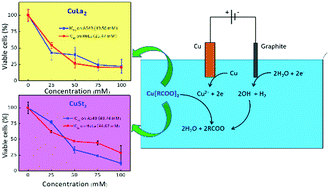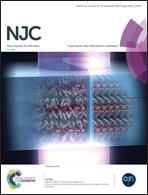Electrochemical synthesis and in vitro cytotoxicity study of copper(ii) carboxylates with different fatty acid alkyl chain lengths†
Abstract
In the present study, an electrochemical technique based on the release of Cu2+ ions from a Cu anode in the presence of unsaturated fatty acids with different alkyl chain lengths has been used to synthesize Cu(II) carboxylates. The fatty acids used in this study are lauric acid (C12 : 0) and stearic acid (C18 : 0). Optimum electrolysis conditions for the synthesis of Cu(II) laurate (CuLa2) and Cu(II) stearate (CuSt2) have been determined to maximize percentage yield and minimize energy consumption and loss of the Cu anode. We observe that both compounds (99.21%) are produced with lower energy consumption (∼21.01 W h L−1) and anode loss (∼0.57 mg L−1) by using the same optimum conditions of 10 V of applied voltage for 4 hours of electrolysis time in 0.1 M CH3COONH4 electrolyte solution. The cytotoxicity study on selected tumor cells (A549 and HeLa) shows that the synthesized compounds have moderate cytotoxic effects with IC50 in the range from 19.50 to 44.67 μM. CuLa2 with C12 alkyl chains provides better cytotoxicity effect on the selected tumor cells due to lower IC50 than CuSt2 with C18 alkyl chains. This shows that the length of alkyl chain also affects the compound toxicity towards selected tumor cells.



 Please wait while we load your content...
Please wait while we load your content...